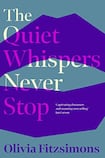
Early in The Quiet Whispers Never Stop, Olivia Fitzsimons’s powerful and uncompromising debut novel, we meet the teenaged PJ Malin drinking in a field with his mates. It’s 1994 in Co Down, and PJ’s binge is interrupted by the news that his sister Samantha – Sam – “has fallen off the roof of the drug den in town”.
PJ and Sam have already been bruised by misfortune in the game of life: their mother vanished long ago and left them in the care of their taciturn farmer father. But at least PJ is not Sam, who ricochets dismayingly through school, relationships, existence. Now PJ, gazing at his unconscious sister in her hospital bed, wills Sam anywhere but here: “You’re not bad but you’re bad here. Here is bad for you. You are bad for us, for here. And that’s when he wants her gone, and he doesn’t feel bad one way or the other about it. […]He wants her to live somewhere else, rather than die here.”
Her life – family, school, sex, drugs, relationships – is an exercise in chaos
PJ’s unspoken thoughts are a manifestation of love – or as close as the novel’s damaged central characters can come to love. In this troubled context, love must be guarded and oblique. Love can be construed as a form of weakness: and weakness can be exploited and punished. With the clarity of vision that trauma can generate, PJ disguises his love for Sam, and understands that his sister must get away if she is ever to flourish.
The 17-year-old Sam is a remarkable creation: courageous yet racked with guilt, mouthy yet fundamentally lacking in confidence, putting it up to the world while fluttering and hollow inside. Her life – family, school, sex, drugs, relationships – is an exercise in chaos; and to this the novel adds a ghastly psychodramatic frisson by pairing her with Naoise, an older man who, we realise, was long ago also in a relationship with her absent mother.
This demanding plot twist is executed with considerable skill: it is evident that Naoise is emblematic of the claustrophobic environment in which these two young women, mother and daughter, have each lived; he is a manifestation of the currents against which they swim in order to achieve a measure of freedom. There is certainly no romanticism at work: Naoise is abusive and violent, as appalling as they come – and the ultimate loser.
The darkness of Naoise’s character matches that of the novel in general – and this darkness is at times profoundly disturbing. The opening scene, for example, plunges into a shocking place of squalor, blood, tears and animal cruelty – and the ending, in explaining this opening, only amplifies its shock and horror.
Conversely, Fitzsimons can deploy lyricism when the circumstances call for it, though her language in general steers well clear of gauzy descriptions of the green fields and rugged Mourne uplands through which her characters move. Sam and her friends are at all times clear-eyed in their attitude to their context – and so, it is implied, should we be.
The book's great achievement is to demonstrate how, in the face of death, atrocity and extraordinary dysfunction, the normal activities of life proceed
This darkness is balanced by a generous measure of bone-dry Northern humour. The Quiet Whispers Never Stop is a marvellous evocation of female youthful energy, with Sam and her convent-school companions in many ways wisecracking Derry Girls transposed to Co Down: they too are plagued by the flint-eyed nuns; they too can run rings around the local boys. When the school is called together in April 1994 to reflect with compulsory solemnity on the announcement of an IRA ceasefire, Sam finds herself more concerned with other headlines – in particular the death of Kurt Cobain (her one true love) the previous day.
This is a novel haunted by the Troubles – the Loughinisland murders of June 1994 are handled with particular intensity and sensitivity – but its great achievement is to demonstrate how, in the face of death, atrocity and extraordinary dysfunction, the normal activities of life proceed with a stubborn, grieved relentlessness.
Recent years have brought a recognition that the politics of Northern Ireland through the course of the Troubles was dominated by the voices and agendas of men, and there has been a renewed attention to the testimony, literary and journalistic, voices of women in those years. New writing by women from Northern Ireland is systematically illuminating this fraught era of the Troubles and their aftermath.
Olivia Fitzsimons is the latest writer to demonstrate the value of a plurality of experiences and provide the means of escape from oppression for characters longing for wider horizons and a measure of liberty that their context cannot provide.











